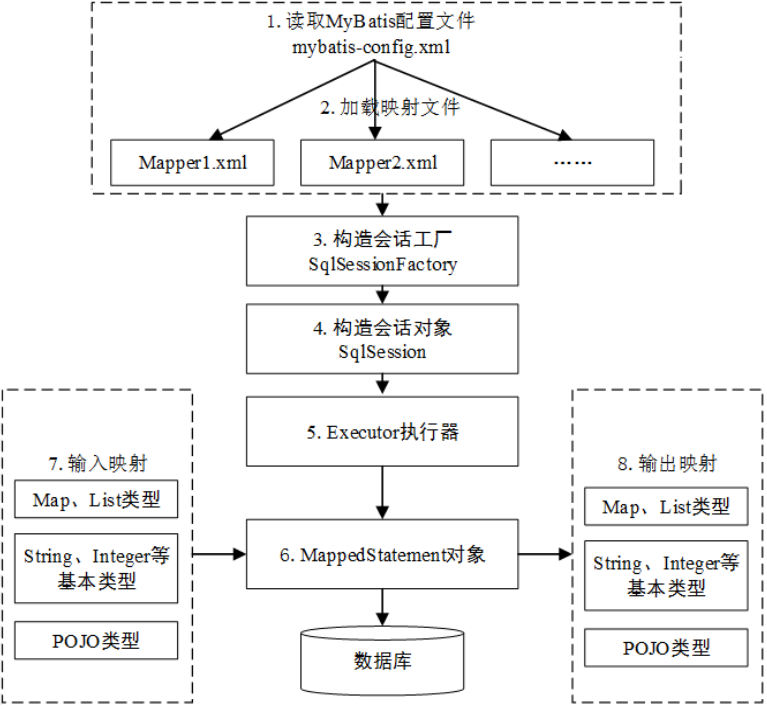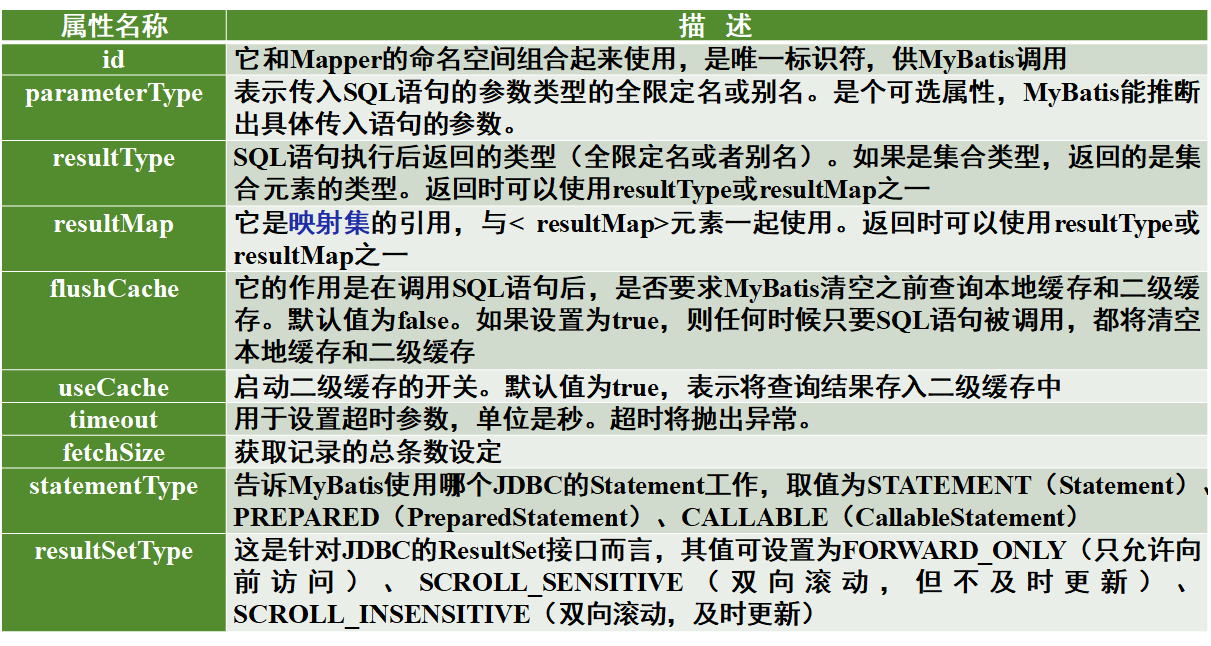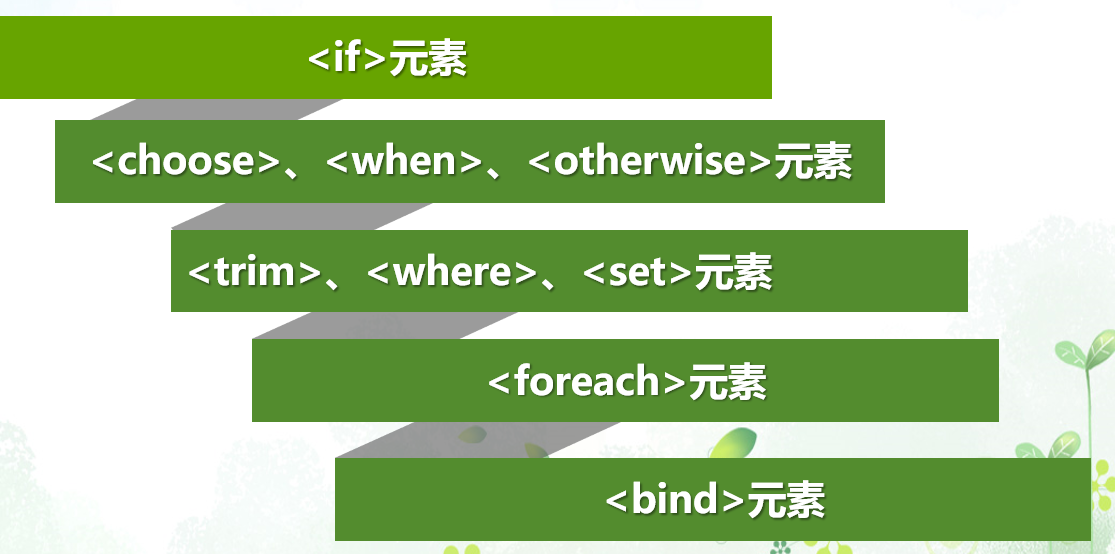MyBatis 使用简单的 XML 或注解用于配置和原始映射
MyBatis 的工作原理

映射器

<select>元素用于映射SQL的select语句<insert>元素用于映射插入语句<update>和<delete>元素用于映射更新和删除语句<sql>元素的作用在于可以定义 SQL 语句的一部分(代码片段)<resultMap>元素表示结果映射集,是 MyBatis 中最重要也是最强大的元素
配置
<configuration>
<!-- 告诉 MyBatis到哪里去找映射文件 -->
<mappers>
<mapper resource="easymall/mybatis/UserMapper.xml"/>
<mapper resource="easymall/mybatis/ProductsMapper.xml"/>
</mappers>
</configuration>
select

<!-- 根据uid查询一个用户信息 -->
<select id="selectUserById" parameterType="Integer" resultType="com.po.MyUser">
select * from user where uid = #{uid}
</select>
insert
<!-- 添加一个用户,成功后将主键值回填给uid(pojo类的属性)-->
<insert id="addUserKey" parameterType="com.pojo.MyUser" keyProperty="uid" useGeneratedKeys="true">
insert into user (uname,usex) values(#{uname},#{usex})
</insert>

update 和 delete
<!-- 修改一个用户 -->
<update id="updateUser" parameterType="com.po.MyUser">
update user set uname = #{uname},usex = #{usex} where uid = #{uid}
</update>
<!-- 删除一个用户 -->
<delete id="deleteUser" parameterType="Integer">
delete from user where uid = #{uid}
</delete>
sql
<sql id="comColumns">uid,uname,usex</sql>
<select id="selectUser" resultType="com.po.MyUser">
select <include refid="comColumns"/> from user
</select>
resultMap
<resultMap> 元素的 type 属性表示需要的 POJO,id 属性是 resultMap 的唯一标识。
子元素 <constructor> 用于配置构造方法(当 POJO 未定义无参数的构造方法时使用)。
子元素 <id> 用于表示哪个列是主键。
子元素 <result> 用于表示POJO和数据表普通列的映射关系。
子元素 <association> 、<collection> 和 <discriminator> 是用在级联的情况下。
<resultMap type="" id="">
<constructor><!-- 类在实例化时,用来注入结果到构造方法 -->
<idArg/><!-- ID参数,结果为ID -->
<arg/><!-- 注入到构造方法的一个普通结果 -->
</constructor>
<id/><!-- 用于表示哪个列是主键 -->
<result/><!-- 注入到字段或JavaBean属性的普通结果 -->
<association property=""/><!-- 用于一对一关联 -->
<collection property=""/><!-- 用于一对多、多对多关联 -->
<discriminator javaType=""><!-- 使用结果值来决定使用哪个结果映射 -->
<case value=""/> <!-- 基于某些值的结果映射 -->
</discriminator>
</resultMap>
例子
ProductsMapper.xml
<?xml version="1.0" encoding="UTF-8"?>
<mapper namespace="easymall.dao.ProductsDao">
<select id="allcategories" resultType="String">
select distinct(category) from products
</select>
<select id="prodlist" resultType="easymall.po.Products" parameterType="map">
select * from products where (price between #{minPrice} and #{maxPrice})
<if test="name!=null and name!=''">
and name like concat('%',#{name},'%')
</if>
<if test="category!=null and category!=''">
and category=#{category}
</if>
</select>
<select id="oneProduct" parameterType="String" resultType="easymall.po.Products">
select * from products where id=#{pid}
</select>
<select id="proclass" parameterType="String" resultType="easymall.po.Products">
select * from products where category=#{category}
</select>
</mapper>
UserMapper.xml
<?xml version="1.0" encoding="UTF-8"?>
<!DOCTYPE mapper
PUBLIC "-//mybatis.org//DTD Mapper 3.0//EN"
"http://mybatis.org/dtd/mybatis-3-mapper.dtd">
<mapper namespace="easymall.dao.UserDao">
<!-- 用户登录功能,返回User类对象 -->
<select id="login" parameterType="String" resultType="easymall.po.User">
select * from user where username=#{username}
</select>
<insert id="regist" parameterType="easymall.po.User" keyProperty="id" useGeneratedKeys="true">
insert into user(username,password,nickname,email) values(#{username},#{password},#{nickname},#{email})
</insert>
</mapper>
动态SQL

<if> 元素是最常用的元素。它类似于 Java 中的 if 语句。
<trim> 元素的主要功能是可以在自己包含的内容前加上某些前缀,也可以在其后加上某些后缀
<where> 元素的作用是会在写入 <where> 元素的地方输出一个 where 语句
在动态 update 语句中,可以使用 <set> 元素动态更新列
<foreach> 元素主要用在构建 in 条件中,它可以在 SQL 语句中进行迭代一个集合
<bind> 元素解决 SQL 映射文件实现不同数据库的拼接函数或连接符号不同的问题







 本文详细解读了MyBatis如何通过XML或注解配置SQL映射,包括<select>、<insert>、<update>、<delete>和<resultMap>的使用,以及配置文件中<mapper>元素和动态SQL的运用实例。
本文详细解读了MyBatis如何通过XML或注解配置SQL映射,包括<select>、<insert>、<update>、<delete>和<resultMap>的使用,以及配置文件中<mapper>元素和动态SQL的运用实例。
















 1657
1657

 被折叠的 条评论
为什么被折叠?
被折叠的 条评论
为什么被折叠?








